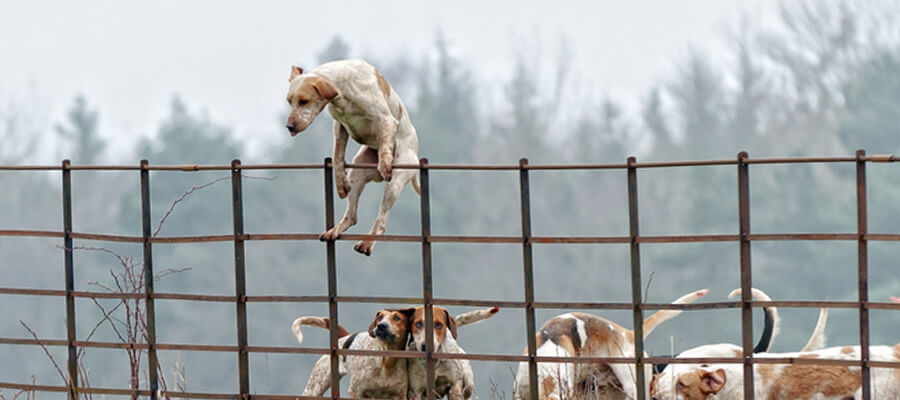
Updated on | by Critter Nets - Blogs
How to Prevent Your Dog from Escaping the Yard
Prevent Your Dog from Escaping the Yard
As a dog owner, there's nothing more concerning than the thought of your furry friend escaping the yard. Whether it's out of curiosity, excitement, or the thrill of adventure, an escaped dog can lead to dangerous situations. Not only can they get lost, but they can also encounter traffic, wild animals, or aggressive dogs. This guide provides practical strategies to prevent your dog from escaping the yard, ensuring their safety and your peace of mind.
1. Install a Secure Fence
A sturdy and high fence is your first line of defense:
- Choose the Right Height: Ensure your fence is at least six feet tall to prevent most dogs from jumping over. For larger breeds, consider adding extensions or a fence that is taller.
- Material Matters: Use materials that are difficult to climb or chew through, such as wood, vinyl, or metal. Avoid chain-link fences, as some dogs can easily escape through them.
2. Check for Gaps and Weak Spots
Essentials for Your Newly Adopted Pet
Welcoming a shelter pet into your life is a beautiful journey. Here are some handpicked items to help your new friend feel safe, loved, and right at home:
Regularly inspect your fence for potential escape routes:
- Routine Maintenance: Periodically check for gaps or loose panels, especially after severe weather. Fill in holes and repair any damaged sections promptly.
- Burrowing Dogs: If your dog has a tendency to dig, consider burying concrete or wire mesh a few inches below the ground along the fence line to deter them.
3. Use a Dog Run
If your yard is large or has limited fencing options, a dog run can be a great solution:
- Secure Area: Create a designated area where your dog can play safely. This space should be enclosed with a strong fence and should include plenty of toys and shade.
- Leash Time: If you're outside but your dog needs to be off-leash, consider using a long lead or tether to give them some freedom while keeping them secure.
4. Consider an Invisible Fence
Invisible fences can be effective for certain dogs:
- How They Work: These systems use a buried wire to create a boundary. When your dog approaches the boundary, they receive a warning beep, followed by a mild static correction if they cross the line.
- Training Required: It's essential to properly train your dog to understand the invisible fence boundaries to ensure they are effective.
5. Provide Adequate Exercise
A tired dog is less likely to escape:
- Daily Exercise: Ensure your dog receives plenty of physical and mental exercise through walks, playtime, and interactive toys. This can help reduce their desire to roam.
- Playdates: Arrange playdates with other dogs or consider doggy daycare to provide socialization and activity.
6. Create a Distraction
Keep your dog entertained within the yard:
- Engaging Toys: Provide toys that stimulate your dog's mind, such as puzzle feeders or chew toys, to keep them occupied.
- Obstacle Courses: Set up agility equipment or create a mini obstacle course in your yard to keep your dog physically and mentally engaged.
7. Secure Garbage and Compost Bins
Curiosity can lead to escape:
- Hide Temptations: Ensure trash cans and compost bins are secured and out of reach to minimize your dog's desire to escape in search of food.
- Pet-Safe Products: Use pet-safe deterrents to keep your dog from sniffing around these areas.
8. Supervise Outdoor Time
Always monitor your dog when they are outside:
- Direct Supervision: Whenever your dog is in the yard, try to supervise their activities. This can help you intervene if they start to dig or attempt to escape.
- Use of Leashes: For extra security, consider using a leash or long line when you’re outside with them, especially if they are known to try to escape.
9. Train Your Dog
Training can play a vital role in preventing escapes:
- Basic Commands: Teach your dog essential commands such as “come,” “stay,” and “leave it.” This can help you maintain control over them when they’re near the fence.
- Desensitization: Gradually expose your dog to distractions that may entice them to escape, rewarding them for staying calm and focused on you.
10. Get Help if Needed
If you continue to have issues with escapes:
- Consult a Professional Trainer: A professional trainer can provide personalized strategies tailored to your dog's behavior and needs.
- Behavioral Assessment: Sometimes, escape attempts may stem from anxiety or behavioral issues. A vet or animal behaviorist can help identify underlying problems and recommend solutions.
Conclusion
Preventing your dog from escaping the yard requires a combination of effective fencing, training, supervision, and providing adequate physical and mental stimulation. By implementing these strategies, you can create a safe and secure environment for your furry friend, allowing them to enjoy their outdoor space without the risk of wandering off. Remember, a well-exercised and mentally stimulated dog is less likely to seek adventure beyond the yard, giving you peace of mind while keeping them happy and healthy.
Affiliate Products
We may earn a small commission when you shop through our links — it helps us keep sharing love and care for every dog out there, at no extra cost to you.

